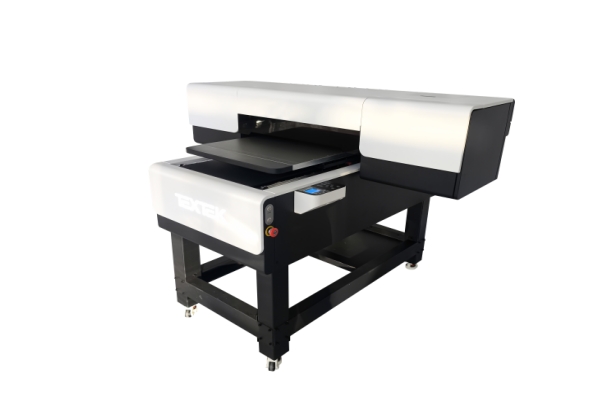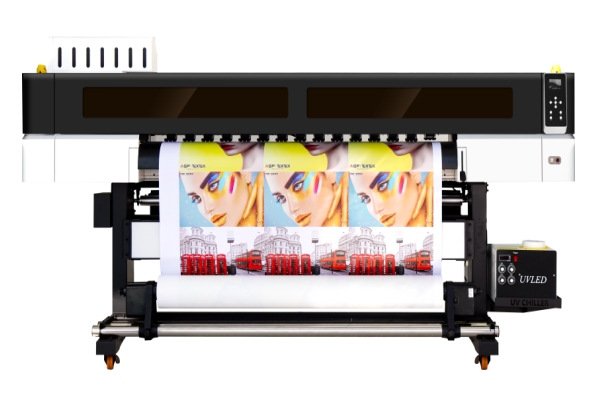21
Feb
UV printing has changed the digital printing industry. It provides rich and colorful prints with long-term durability and the ability to print on various materials If you are a business owner looking to learn about UV printing to incorporate it, it is important to understand the differences between flatbed and roll-to-roll UV printers.
In this article, we discuss the two main types of UV printers, their differences, and factors to consider when choosing the ideal printer for your business.
UV printers use ultraviolet light to cure the ink as it is being printed. Unlike other inks, which need heat or air to dry, UV-curable inks dry quickly under UV light. This technology increases the speed of printing and the durability and quality of the prints. UV printing is suitable for both hard surfaces such as wood, metal, and glass and soft surfaces such as vinyl and fabric.
The greatest advantage of UV printing is that you can print on nearly any surface without the fear of ink fading or discoloring in the long run. Their ability to work with various materials has made UV printing popular in industries like advertising, packaging, and home decor.

Flatbed UV printers have a stationary printing surface. These printers offer the following benefits:
Flatbed printers allow you to print on rigid materials such as wood, metal, glass, and plastic. Their stable and flat surface ensures that even heavy or rough materials are printed with the same quality.
Flatbed printers can produce high-resolution designs because the print head moves over a stationary object.
Most flatbed printers have the option of adjustable platens so that you can handle different sizes of products. Custom orders often demand you to work with products of different sizes and flatbed printers are ideal for that.
Flatbed printers have a simple design. They are less complex than roll-to-roll printers, so working with them is easier even if you are a beginner.

Roll-to-roll UV printers are designed for printing on a large scale on flexible materials. They have the following benefits:
Roll-to-roll printers work with continuous rolls of material. This feature makes them perfect for making mass-production items like banners or wallpaper.
Roll-to-roll printers can print faster than flatbed printers because they work on a continuous feed system. This is a big advantage when you have to produce large quantities in a short time.
Roll-to-roll technology can work with many materials like vinyl, textiles, and thin plastics.
Roll-to-roll printers allow you to set up a continuous production line with very few interruptions because they require less downtime between prints. This feature makes them, and consequently you, more efficient.
You need to consider the following factors when choosing a UV printer, learning these will help make an informed choice:
If your production needs require printing on rigid materials like wood, metal, glass, or acrylic, a flatbed UV printer is the best option for you. On the other hand, if you have to print on flexible substrates like fabrics, vinyl, or paper, choose a roll-to-roll printer.
Roll-to-roll printers are made for high-volume production. If you have to print large quantities of banners, fabrics, or wallpapers, you can do that in a short amount of time using a roll-to-roll printer. If your business experiences a lot of variation in size or type of materials, a flatbed printer is the better option.
Flatbed printers are usually better for projects that need more detailed and high-resolution photos. Their fixed print bed means less movement so every area of your design is clear and vibrant. While roll-to-roll printers provide excellent quality for bulk orders, they will not provide the same quality of detail as flatbed printers.
Flatbed printers need a higher initial cost due to their heavy-duty make and more high-resolution capability but they offer long-term value if your business requires high-quality output.
Roll-to-roll printers are more economical for high-volume printing. They have less downtime and save labor costs. Consider your budget and production scale to figure out which printer will give you the best return on investment.
Flatbed printers usually need a larger space for operation because they are designed to handle large and varied materials. They function well in environments where space is not a problem.
Roll-to-roll printers are usually smaller, especially industrial or business-purpose ones. If you have less space but want to handle large volumes, roll-to-roll printers are better for you.
Both printer types require regular maintenance, but it varies. Flatbed printers require more manual tweaking due to the broad range of materials they can print.
Roll-to-roll systems operate continuously and most of them have automated maintenance. Ensure that the manufacturer has good customer service and training. Having technical support available can increase productivity.
The choice of UV printer depends on your unique production requirements and business objectives. Flatbed UV printers provide high-resolution printing on rigid substrates, while roll-to-roll printers provide high-speed, non-stop printing on flexible materials. Material type, production quantity, print quality, budget, and working space should be considered to make the right choice for your business. Learning the pros and cons of both types and their differences will help you a lot while making the decision.
In the rapidly evolving digital printing world, staying informed and choosing the right equipment is essential. Whether you opt for a flatbed or roll-to-roll UV printer, the goal remains: to deliver vibrant, durable prints that stand out in quality and creativity. Make your decision with confidence, knowing that your chosen printer will be a key asset in bringing your creative visions to life.
